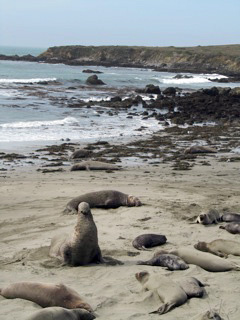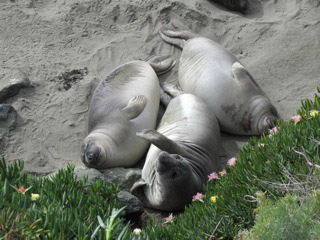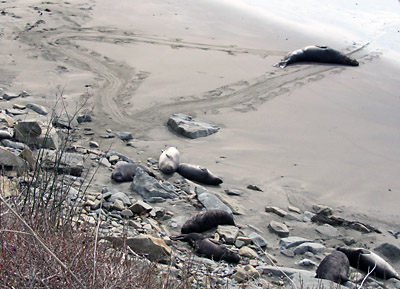 A beachmaster at Piedras Blancas A beachmaster at Piedras Blancas
Beach Fever from Behind the Guard Rail
by Jane Gilbertsen
Awaiting gardening season, I escaped the February gloom by jetting down to California to visit family. I had contacted Christine Heinrichs, the famous chicken author and elephant seal docent for a personal tour of the Piedras Blancas elephant seal colony.
Piedras Blancas, now part of a National Marine Sanctuary, is one of the few major colonies accessible to the public. (People and seals are separated by only a small beachhead and a nice guardrail.) Almost all other major colonies are offshore islands. It is the southernmost edge of their territory and has been re-inhabited since the 1990's as the entire population grew from a genetic bottleneck of less than 1,000 to about 180,000 individuals. Recovery has run about 6% per year. Happily, the whole area has enjoyed recent additional protection as the surrounding Hearst Castle estate became 13 more miles of ocean beach state park and 80,000 acres of ranch uplands became part of a land trust.
What is even more amazing is that this is probably not the only big comeback for the elephant seal. When people first appeared in the New World over 10,000 years ago, they killed off the megafauna, both prey and predator. Before man appeared, a big predator like the saber tooth tiger would have slaughtered the tasty seals on a coastal beach. Maybe all the seals. Months of basking, birthing, nursing, mating and molting would have made them really big "sitting ducks". Recent studies of ancient coastal Indian middens reveal little or no sign of the elephant seal. It is thought the last Holocene (pre-Pleistocene) refuge of the elephant seal was Guadalupe Island 183 miles out from Baja California. No megafauna or human predators there.
 Youngish bull lookin' for love. Is she welcoming or not? Young pup not ready to share. Youngish bull lookin' for love. Is she welcoming or not? Young pup not ready to share.
 Pups gain 30 pounds a day for 30 days. These weaners will have to make it on their own very soon. Pups gain 30 pounds a day for 30 days. These weaners will have to make it on their own very soon.The seals were busy on the day of my visit. We watched the big males jockeying for position in anticipation of breeding. When a beachmaster moved a bit, all the junior bulls had to move a respective distance accordingly. It was like watching slow motion giant dominoes. Young dark still-thin pups were nursing, older pups appropriately called "weaners" laid around fat and happy, and the moms, nearly free of their pups, were approached for mating.
After about three months of eating primarily deep-ocean invertebrates like squid, adults regain blubber lost while laying around birthing, nursing and breeding. While in the open ocean, males cruise at great depth for food in their voyage toward the Aleutians. The females spread out from the Northwest to the Aleutians or stay far out mid-Pacific. Weaners have to learn to both swim and eat on their own closer to shore. Normally half the weaners don't make it.
 Adults will be crossing right through the estimated 25 million TONS of floating debris from Japan's earthquake and tsunami. The debris is expected to hit our Pacific coast in late 2013. The first stuff should beach on the northwest Hawaiian coast later this summer. Hawaii's experience will give mainlanders an early taste of things to come. A big 25% of the debris is expected to land on our western beaches, 25% is expected to float forever in the Great Pacific Garbage Patch, 25% is expected to sink and 25% is expected to float on back to Japan. Bob Delong, NOAA research biologist for the elephant seal, is hopeful it won't pose a big issue for the seals as they tend to eat primarily their traditional deep ocean food and not haul out on islands of floating garbage. The beach will pose another challenge if it’s deep in tsunami trash.
Remember my comment about that guard rail? Well, after the seals started resettling the beach, occasionally a bull hauled up to bask on the highway. Not good. So Highway 1 was moved a bit in, an observation parking lot was built and eventually that guard rail was installed to divide man and beast from each other. It also took lots of public education to keep people on their own side of the rail. The seals look slow and calm until they aren't. Bob Delong thinks the docents like my friend Christine are greatly responsible for the safety of the resident colony from people. They are people teaching people.
Protecting the habitat was not enough, for in May 2008, a local man shot three young bulls in the head. He thought the seals were to blame for the closing of the commercial salmon season (they don't eat salmon). This is another example of predator competition, although totally misguided.
Good investigative work and the misbehavior of related parties helped locate the fisherman. The shooting was a community tragedy: people were shocked. This community treasured the privilege of hosting such magnificent creatures and were proud of their stewardship. People now come from all over the world to visit Piedras Blancas and celebrate the recovery of a magnificent animal.
 From the beachmaster to us - a lovely heart in the sand. From the beachmaster to us - a lovely heart in the sand.
Back to you Big Guy!
Thanks to sister Annie for great photos from our side of the guard rail,
Jane
|
